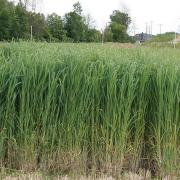Frequently Asked Questions – FAQs
Sponsoring Partner

Funded by AFRI. Learn More.

- Why is it important to be able to grow a consistent and uniform supply of a biomass feedstock?
- Will switchgrass grow well in my region?
- When should I plant switchgrass?
- Should I fertilize switchgrass when I plant it?
- Will weeds be a problem after my switchgrass stand is established?
- How high should I cut switchgrass? I am growing it as a bioenergy crop.
- Can I use my regular haying equipment to harvest switchgrass grown for biofuel?
- How can I get a switchgrass crop to dry faster in the field once it’s been cut for biomass?
- How can I reduce dry matter losses to a biomass crop during storage?
- What effects do corn stover removal rates have on greenhouse gas emissions from cropland?
- Can the use of conservation tillage help reduce greenhouse gas emissions from cropland soils where residues are used for biofuel?
- How do I grow switchgrass to provide biomass to be used in the production of biofuels?
- Is there a market for switchgrass for biofuel and how do I get started?
- Can you feed switchgrass to livestock until a biofuel market develops for it?
- Should I begin establishing switchgrass in case they put a cellulosic ethanol plant near by?
Why is it important to be able to grow a consistent and uniform supply of a biomass feedstock?
It’s important to buyers, who rely on predictable quality and quantity of feedstocks. Because feedstocks are hard to transport long distances and transportation can be interrupted outside forces such as weather, refiners look for dependable supplies. They also need the quality of the feedstock to be consistent for the most efficient and profitable conversion into bioenergy.
Find more detailed information in this article: Logistical Challenges to Switchgrassas a Bioenergy Crop. Contributor: Amy Kohmetscher, Distance Education Specialist, University of Nebraska-Lincoln, and CenUSA Bioenergy collaborator.
Will switchgrass grow well in my region?
Switchgrass is a warm-season grass native to most of North America except the West Coast, and it should thrive in any area suitable for dryland corn.
Cultivars specific to regions are available for most of the United States. In the southern and mid-latitude regions, lowland cultivars such as Alamo and Kanlow grow well. In mid- and northern latitudes, upland cultivars, such as Shawnee and Sunburst, are best suited. New cultivars are being released for most regions, so check regularly with your local experts for cultivar selection.
For more detailed information, see this article on successful establishment of switchgrass. Contributor: Rob Mitchell, USDA-ARS Grain, Forage, and Bioenergy Research Unit, and CenUSA Researcher.
When should I plant switchgrass?
The best planting date for switchgrass in your region will depend on soil temperature, and moisture. It will range from late March in the Southeast to late June in the northern Great Plains. A good rule of thumb is to plant switchgrass two to three weeks before or after the best date to plant corn in your area.
For more detailed information, see this article on successful establishment of switchgrass. Contributor: Rob Mitchell, USDA-ARS Grain, Forage, and Bioenergy Research Unit, and CenUSA Researcher
Should I fertilize switchgrass when I plant it?
Do not apply nitrogen (N) fertilizer or manure in the year that switchgrass is planted, because too much N encourages weeds that compete with the seedlings, and boosts your cost of establishment. Take a soil test in the fall before seeding to find out if phosphorus and potassium need to be applied to encourage root growth.
For more detailed information, see this article on successful establishment of switchgrass. Contributor: Rob Mitchell, USDA-ARS Grain, Forage, and Bioenergy Research Unit, and CenUSA Researcher
Will weeds be a problem after my switchgrass stand is established?
Weeds typically are not a problem after a switchgrass stand is established, because mature switchgrass plants tend to out-compete weeds. However, this requires good fertility and harvest management.
An established, well-managed switchgrass field might require herbicide applications* one to three times every ten years to control broadleaf weeds, though in some states there are no herbicides labeled for use on switchgrass..
If cool-season grasses like Kentucky bluegrass or smooth bromegrass become a problem, harvest switchgrass after it’s dormant but while the cool-season grassy weeds are still growing and apply glyphosate* at 1 to 2 quarts per acre.
Check with your Extension agent to find out if there are herbicides labeled for use on switchgrass in your state.
For more detailed information see: Control Weeds in Switchgrass. Contributor: Rob Mitchell, USDA-ARS Grain, Forage, and Bioenergy Research Unit, Lincoln, NE.
How high should I cut switchgrass? I am growing it as a bioenergy crop.
Mow switchgrass to a 4- to 6-inch stubble. Although leaving extra height will cut down on yields somewhat, it will help the stand survive the winter by trapping protective snow cover, as well as reduce tire damage from the hard stubble.
For more detailed information, see this article on How to Successfully Harvest Switchgrass Grown for Biofuel. Contributor: Kevin Shinners, CenUSA Researcher; Professor of Agricultural Engineering, University of Wisconsin
Can I use my regular haying equipment to harvest switchgrass grown for biofuel?
You can use the equipment traditionally used to harvest forage crops, but because the switchgrass should have high yields, the equipment will perform differently. Ground speed and field productivity will be lower, for example. Use a disk cutter-bar mower and adjust it for higher yields of biomass.
See the CenUSA article How to Successfully Harvest Switchgrass Grown for Biofuel for more complete information. Contributor: Kevin Shinners, Professor of Agricultural Engineering, University of Wisconsin and CenUSA Researcher
How can I get a switchgrass crop to dry faster in the field once it’s been cut for biomass?
Research shows that the most effective method for quicker drying is a combination of intensive conditioning to crush and shred the stems, and wide swathing across the full cut-width.
See the CenUSA article How to Successfully Harvest Switchgrass Grown for Biofuel for more complete information. Contributor: Kevin Shinners, Professor of Agricultural Engineering, University of Wisconsin and CenUSA Researcher
How can I reduce dry matter losses to a biomass crop during storage?
Paying attention to storage practices can cut down on DM losses, which could run as high as 25 percent%. For instance, losses from large round bales are typically less than from large square bales, silos or Ag-bags.
But you should carefully compare costs—it may be cheaper to accept some DM loss compared to buying a new baler or constructing a building.
Find more detailed information in this article: Logistical Challenges to Switchgrassas a Bioenergy Crop Contributor: Amy Kohmetscher, Distance Education Specialist, Ohio State U., and CenUSA Bioenergy collaborator.
What effects do corn stover removal rates have on greenhouse gas emissions from cropland?
In general, higher rates of residue removal decrease greenhouse gas emissions because there is less carbon and nitrogen returned to the soil. However, producers must take into account other impacts of stover removal, including a higher risk of soil erosion or lower soil productivity.
For more detailed information, see this article on Management Practices Impact Greenhouse Gas Emissions in the Harvest of Corn Stover for Biofuels. Contributor: Virginia L. Jin, Research Soil Scientist, USDA-Agricultural Research Service.
Can the use of conservation tillage help reduce greenhouse gas emissions from cropland soils where residues are used for biofuel?
Yes, tillage practices such as no-till and reduced-till have been found to mitigate the production of carbon dioxide and nitrous oxide, two major atmospheric greenhouse gases.
For more detailed information, see this article on Management Practices Impact Greenhouse Gas Emissions in the Harvest of Corn Stover for Biofuels. Contributor: Virginia L. Jin, Research Soil Scientist, USDA-Agricultural Research Service.
How do I grow switchgrass to provide biomass to be used in the production of biofuels?
Switchgrass is a perennial grass native to North America. There are a number of considerations regarding production methods. Switchgrass takes as much as 2-3 years to reach a fully established, mature stand. Additional details regarding production and harvesting can be found at Switchgrass for Biofuel Production. You will find links to additional resources at this site. Contributors: Clark Garland and Tina Johnson, University of Tennessee
Is there a market for switchgrass for biofuel and how do I get started?
Currently, there is no open market for switchgrass. Switchgrass for biofuel is normally produced under a contractual arrangement. After a person has a satisfactory contract, the producer should consult with the end user to confirm product requirements and specifications, such as plant variety and in what form the switchgrass is to be harvested. For more information see Biomass Feedstocks and Energy Independence and Feedstocks for Biofuel Production. Contributors: Clark Garland and Tina Johnson, University of Tennessee
Can you feed switchgrass to livestock until a biofuel market develops for it?
Switchgrass, like a number of other warm-season grasses, can produce high-quality forage. Early season harvesting produces the highest quality. As the production season progresses, crude protein content quickly declines. If switchgrass is allowed to mature and become fibrous, forage quality will suffer drastically. Switchgrass can be grazed by beef and dairy cattle, but other forages could be more acceptable for given resource situations. Switchgrass hay is not recommended for horses. Additional details can be found in the publication, Using Switchgrass for Forage. In evaluating the economics of grazing and establishing switchgrass in anticipation of a market for biomass, the producer should feel fairly confident the biomass market may develop within a reasonable time period. Contributors: Clark Garland and Tina Johnson, University of Tennessee
Should I begin establishing switchgrass in case they put a cellulosic ethanol plant nearby?
Producing switchgrass for energy generally occurs under some form of contractual arrangement with the end user. Due to potential risk, farmers should establish switchgrass after they have obtained a production contract with anticipated satisfactory returns, or have plans for an alternative use for the crop. For more information on switchgrass production see Switchgrass for Biofuel Production Contributors: Clark Garland and Tina Johnson, University of Tennessee
CenUSA Bioenergy is a coordinated research and education effort investigating the creation of a regional system in the Central US for producing advanced transportation fuels from perennial grasses on land that is either unsuitable or marginal for row crop production.* In addition to producing advanced biofuels, the proposed system will improve the sustainability of existing cropping systems by reducing agricultural runoff of nutrients in soil and increasing carbon sequestration.
CenUSA is supported by Agriculture and Food Research Initiative Competitive Grant no. 2011-68005-30411 from the USDA National Institute of Food and Agriculture.

